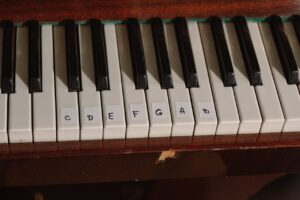Have you ever felt like your chords sound too simple or flat? Incorporating extended chords on piano can transform your music by adding depth and complexity. Chord extensions go beyond basic triads and seventh chords, introducing richer harmonies that elevate your playing.
Essential in genres like jazz, classical, and contemporary music, extended chords bring emotional texture and sophistication to your sound. In this article, we will explore the basics of chord extensions – focusing on ninths, elevenths, and thirteenths. You will learn what they are, how to play them and how to use them to enhance your music. By the end of this article you will understand these beautiful harmonies and be able to start incorporating them into your compositions and performances.
- Fall in love with the music - Learn your favorite songs, at a level suitable for you.
- Enjoy interactive piano lessons - Explore courses covering music theory, technique chords & more.
- Get real-time feedback - Skoove's feedback tells you what went well and what needs practice.

What are chord extensions?
Chord extensions are notes added beyond the seventh in a chord. The typical triad (root, third, and fifth) forms the foundation. When you add the seventh note of the scale, you get a seventh chord.
What if you want even more complexity? That’s where ninths, elevenths, and thirteenths come in. These are the extended notes that go beyond the seventh, creating rich, layered harmonies.
When playing extended chords on the piano each type of extension has its own role, providing a distinct color or mood to the chord. Learning how to use them effectively can make your playing sound more sophisticated and emotionally resonant.
Basic chord structure recap
Before diving into the specifics of extended chords, let’s quickly recap the basics of chord structure.
- Triads: A triad is the simplest chord, consisting of the root, third, and fifth. For example, a C major triad includes C (root), E (third), and G (fifth). Triads form the foundation of all extended chords, and understanding their structure is key to building chord progressions and more complex harmonies.
- Seventh chords: Adding the seventh note of the scale to a triad gives you a seventh chord. For example, a C major seventh chord (Cmaj7) includes C, E, G, and B. Sevenths add depth to chords and are a natural gateway to understanding chord extensions.
Once you’re comfortable with triads and seventh chords, you can begin to add ninths, elevenths, and thirteenths to create extended chords.
Check out this youtube video to familiarize yourself with the sound of some of these chords:
Understanding ninth chords
A ninth chord is created by adding the ninth note of the scale on top of a seventh chord. In the key of C, the ninth is the note D. So, a C major ninth chord (Cmaj9) consists of C, E, G, B, and D.
Types of ninth chords
- Major ninth (Maj9)
Formed by adding a major ninth to a major seventh chord. For example, Cmaj9 contains C, E, G, B, and D.
- Minor ninth (m9)
Formed by adding a major ninth to a minor seventh chord. For example, Cm9 consists of C, E-flat, G, B-flat, and D.
- Dominant ninth (9)
A dominant seventh chord with a major ninth. For example, C9 includes C, E, G, B-flat, and D. Dominant ninth chords are frequently used in jazz and blues, giving them a sense of tension and anticipation.
- Dominant flat ninth (7♭9)
A dominant seventh chord with a flattened ninth, often used in jazz and blues for added tension. For example, C7♭9 contains C, E, G, B-flat, D-flat. The flattened ninth (D♭) creates dissonance, which resolves smoothly to more stable chords, making it perfect for transitions and building anticipation.
How to play ninth chords on the piano
Playing ninth chords can seem tricky at first because they span five notes, but there are ways to simplify them. You can distribute the notes between both hands to make the chord extensions easier to play. For example, you could play C and E with your left hand and G, B, and D with your right hand.
Another tip is to omit certain notes, like the fifth or the root, if the chord feels too dense. This is especially useful when playing with other instruments that may cover those notes, like a bass guitar covering the bass clef notes on piano. You can also rearrange larger chords like this, putting the notes in different orders to make them more interesting or easier to play. This is known as voicing.
Here is a great lesson from Skoove to help you with playing chords with proper hand technique and movement.
Where to use ninth chords
Ninth chords add richness to many genres, including jazz, R&B, and pop. One famous example is the opening chord of The Beatles’ “A Hard Day’s Night,” which features a dominant ninth. If you’re looking to add more complexity and depth to your playing, ninth chords are a great place to start.
Exploring eleventh chords
An eleventh chord is built by adding the eleventh note of the scale to a ninth chord. In the key of C, the eleventh note is F. A C major eleventh chord (Cmaj11) consists of C, E, G, B, D, and F. Eleventh chords are often used to create a sense of suspension or unresolved tension
Types of eleventh chords
| Major eleventh (Maj11) | Built on a major triad and includes the major seventh, ninth, and eleventh. For example, Cmaj11 contains C, E, G, B, D, and F. |
| Dominant eleventh (11) | A dominant seventh chord with an added eleventh. For example, C11 consists of C, E, G, B-flat, D, and F. Dominant elevenths are frequently used in jazz, and they have a suspended quality due to the inclusion of the fourth scale degree (F). |
How to play eleventh chords on the piano
Eleventh chords require playing six notes so it’s important to use efficient hand positioning. Spread the chord across both hands, with some notes in the left and others in the right, to avoid making it sound too crowded. You can also omit the third or fifth if needed to make the chord extensions more manageable. Have a go at rearranging this for easier voicings.
Where to use eleventh chords
Eleventh chords are common in jazz and other improvisational styles. You can hear them in Wayne Shorter’s “Footprints,” where dominant elevenths create a modal jazz sound. Eleventh chords give your music a more spacious, open feel, making them perfect for passages that need a floating, unresolved quality.
Unpacking thirteenth chords
A thirteenth chord is the most complex of the extended chords, containing seven notes. In the key of C, a C major thirteenth chord (Cmaj13) consists of C, E, G, B, D, F, and A. Because these chords span the entire scale, they produce a lush, full sound that works well in many styles of music.
Types of thirteenth chords
- Major thirteenth (Maj13)
Contains the root, third, fifth, seventh, ninth, eleventh, and thirteenth. Example: Cmaj13 (C, E, G, B, D, F, A).
- Dominant thirteenth (13)
A dominant seventh chord with added ninth, eleventh, and thirteenth. Example: C13 (C, E, G, B-flat, D, F, A).
How to play thirteenth chords on the piano
Thirteenth chords are expansive, so it’s common to leave out some notes, such as the fifth or even the root, particularly when playing in a band or ensemble. This makes the chord extensions easier to play while still capturing the essence of the harmony.
As before, using different voicings is another way to manage the large span of a thirteenth chord. Playing the chord in different positions can help you fit it more naturally into your hand and sound smoother in a progression.
Where to use thirteenth chords
Thirteenth chords are a staple of jazz, R&B, and soul music. You can find them in songs like “Giant Steps” by John Coltrane, where their full, rich sound adds depth and sophistication to the chord structure.
Tips for success
Mastering extended chords requires time and practice, but these tips can help you make the most of your learning process:
- Start simple: Begin with the ninth chords before moving on to the elevenths and thirteenths. This way, you can gradually build your understanding without overwhelming yourself with too many notes at once.
- Break the chord down: If a full extended chord feels too complex, simplify it. Focus on playing the root, seventh, and the extension (ninth, eleventh, or thirteenth). This will still give you the essence of the chord without requiring you to play every note.
- Practice with progressions: Extended chords sound best in the context of progressions. Try incorporating ninths, elevenths, and thirteenths into common progressions like ii-V-Is to solidify your understanding.
- Experiment with inversions and voicings: Playing chord inversions and experimenting with different voicings can make extended chords easier to manage. Spread the notes out across the piano to create a more open, balanced sound.
Common progressions using extended chords
Extended chords often feature prominently in specific chord progressions. Here are a few to practice:
- ii-V-I: In jazz, the major ii-V-I progression often includes a dominant ninth or thirteenth chord on the V and major seventh or 9 on the I. This progression is the backbone of countless jazz standards and is a great way to practice extended chords in context.
- I-IV-V: In blues, the dominant ninth and thirteenth chords add extra color to the classic I-IV-V progression. The tension created by these extensions resolves beautifully back to the I chord.
- Suspended progressions: Extended chords like elevenths often feature in progressions that use suspended resolutions. These chords create a sense of anticipation.
Working through these progressions regularly will help you become more comfortable with extended piano chords and improve your ability to use them in various musical contexts.
Here is another great lesson from Skoove. This tutorial will help you familiarize yourself with expressive chords and how to create an effective routine. Happy practicing!
Conclusion
Extended chords such as ninths, elevenths, and thirteenths are powerful tools for adding emotional depth and harmonic richness to your piano playing. By learning their structure and practicing them in various contexts, you can elevate simple chord progressions into more expressive and dynamic musical statements.
Don’t be afraid to experiment with different voicings and progressions as you incorporate these chords into your repertoire. With regular practice, extended chords will soon feel natural in your playing. For more structured learning, Skoove offers lessons that focus on extended chords and other essential piano skills, guiding you step by step toward mastery. Keep practicing and watch these chords transform your music!
Author of this blog post:
Susana Pérez Posada

With over seven years of piano education and a deep passion for music therapy, Susana brings a unique blend of expertise to Skoove. A graduate in Music Therapy from SRH Hochschule Heidelberg and an experienced classical pianist from Universidad EAFIT, she infuses her teaching with a holistic approach that transcends traditional piano lessons. Susana’s writings for Skoove combine her rich musical knowledge with engaging storytelling, enriching the learning experience for pianists of all levels. Away from the piano, she loves exploring new places and immersing herself in a good book, believing these diverse experiences enhance her creative teaching style.
Published by Lydia Ogn from the Skoove team














